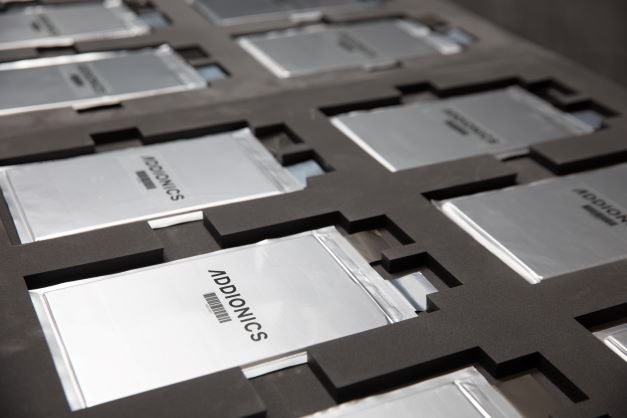

Can you describe Addionics’ technology, including the difference between 2D and 3D battery structures?
While most efforts to improve batteries focus on chemistry, Addionics focuses on physics. Our approach improves all key battery performance metrics simultaneously and has been shown to achieve batteries with higher capacity, reduced charging time, extended lifetime, and enhanced safety – all without increasing costs.
Traditionally, electrodes have 2D structures using dense metal foils, on which the active material is layered on top. But this 30-year-old 2D structure has reached a limit in its ability to achieve key performance parameters required to meet the demands of electrification. In EV applications, for example, automakers often have to compromise power for energy, or vice versa. Our 3D structure, on the other hand, uses porous materials which allow for active material to be integrated throughout and at higher loads, which results in batteries with higher capacity.
We use an in-house AI algorithm to optimize the best electrode structure according to different battery application requirements, which accelerates development and reduces manufacturing costs.
What problems is Addionics’ technology solving?
Companies have spent billions on battery development over the past 30 years, with only incremental improvements to show. While a majority of efforts to date have focused primarily on battery chemistries, next-generation challenges require a stronger focus on battery physics — and that’s exactly what Addionics is doing. Our technology creates high power, high energy batteries, regardless of chemistry makeup.

US Tariffs are shifting - will you react or anticipate?
Don’t let policy changes catch you off guard. Stay proactive with real-time data and expert analysis.
By GlobalDataBattery safety is a huge issue for the EV industry right now. How does your technology address this?
EV battery fires, although rare, are a huge detriment to EV adoption and consumer confidence. Fires are related to “thermal runaway” issues – when the thin membrane that separates an anode and a cathode is damaged and short-circuits. The high energy stored in the battery is released quickly, leading to battery fire and even explosion. Just as with energy density and internal resistance, changing the design of the battery cell provides a more efficient route to enhancing safety than current approaches. Our 3D Electrode design improves heat dissipation, thermal uniformity and mechanical stability to improve battery lifespan and reduce the risk of phenomena leading to explosions and fires.
What makes Addionics different from competing battery technologies?
Addionics’ chemistry agnostic approach is our key differentiator. We can improve batteries with any chemistry – existing or emerging. We didn’t invent the concept of 3D structures, nor were we the first to understand the benefits. But the problem was a lack of a cost-effective manufacturing process to develop the required metals. We have solved this by developing a new scalable and cost-effective metal fabrication process for both the anode and the cathode – the core IP of Addionics. With the combination of Addionics’ patented manufacturing process and AI algorithm, manufacturers can build high-performance batteries with reduced market prices at the giga scale.
Who are Addionics’ main audiences?
Currently, our primary focus in terms of customers is automotive OEMs and suppliers, but our technology can also be applied to consumer electronics, micro-mobility solutions, medical devices, aviation and drones, aerospace and defense, and residential energy storage. Addionics has 5 commercial projects underway within the automotive space with leading companies OEMs, Tier-1, and Conglomerates. These projects are paid, and each one focused on another battery chemistry integrated with our Smart 3D Electrodes – to also demonstrate our vision. We will be applying the $27 million we recently raised in our Series A to further this work and expand our team in the U.S. and Europe.
How might Addionics impact the EV and energy storage industries?
Addionics’ technology enables better performing, cheaper and safer batteries, which are critical to achieving planned EV targets, to deploy energy storage at scale, and ultimately wean the world off fossil fuels. Our Smart 3D Electrode design enables more active material per unit area, which doubles drive range (overcoming consumer anxieties) and lowers internal resistance, which improves accessible capacity and reduces battery charging times by up to 50%. All of these factors can help accelerate lower cost, better performing EVs to more quickly get them on the road.
With respect to residential energy storage, low-cost batteries are helpful, but battery safety is critical. Batteries must be resilient to malfunction and overheating to avoid the risk of fires at the home. Addionics’ technology helps energy storage companies build safer, higher-performing batteries at a lower cost to meet the growing market opportunity for these solutions, and encourage consumers to adopt home energy systems paired with rooftop solar panels.
What are the company’s thoughts on the different battery chemistries gaining popularity today?
Keep ‘em coming! No matter the chemistry, Addionics can improve battery performance. Rather than bet on a single horse, we put our money on the entire race. But it’s critically important that industry continues to invest in chemistries outside the Li-ion family such as lithium iron phosphate (LFP), silicon and solid-state. We believe LFP will be most commonly used in the near term, and we’re currently working with a partner to improve connectivity using Smart 3D Electrodes. Silicon batteries are also great, but they’re not stable. Addionics improves silicon batteries because our metal framework prevents swelling or shrinking, which causes early degradation and safety issues. We’re also working on solid-state batteries with our partner, Saint Gobain to solve the anode-cathode capacity mismatch and develop higher energy, more mechanically stable solid-state batteries.



